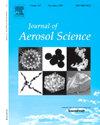气溶胶物理特征描述:气溶胶文献标准和校准策略现状综述
IF 3.9
3区 环境科学与生态学
Q2 ENGINEERING, CHEMICAL
引用次数: 0
摘要
气溶胶对气候、空气质量、人类健康和农业有着广泛的影响。尽管气溶胶测量科学和技术不断进步,但在许多应用中,气溶胶物理特性量化的不确定性仍然很大。准确描述气载粒子的特性(包括数量和质量浓度、粒度分布和光吸收)对于了解它们在大气中的行为和环境归宿至关重要。我们将深入探讨气溶胶的物理特性,重点介绍测量和文件标准,这些标准是测量可追溯性的基础,可以对不同时间或地点基于测量原理的仪器所收集的数据进行比较。在粒子计量学方面,最近的进步带来了先进的初级测量标准,相对扩大的测量不确定性可低至 1.1%(覆盖因子 k = 2;置信区间 95%)。通过这些标准,可以对仪器进行及时、经济的校准,从而为研究、工业和立法提供支持。我们讨论了与空气质量以及车辆、航空、航运和固定污染源颗粒物排放控制有关的文件标准和法规,旨在提高对这些文件的认识,并强调气溶胶科学不同子领域测量协议的差异。重要的是,我们强调了进一步统一测量程序的必要性,提供了具体的例子,并为实现这一目标提出了建议。本综述全面涵盖了不同子学科的气溶胶测量和文件标准,可作为有志于提高测量精度的科学家和监管人员的可靠指南。本文章由计算机程序翻译,如有差异,请以英文原文为准。
Aerosol physical characterization: A review on the current state of aerosol documentary standards and calibration strategies
Aerosols have a wide-ranging impact on the climate, air quality, human health, and agriculture. Despite the ongoing advances in aerosol measurement science and technology, the uncertainties in quantifying aerosol physical properties remain significant in many applications. The accurate characterization of airborne particles - including number and mass concentration, size distribution and light absorption - is critical for understanding their behavior in the atmosphere and environmental fate. We delve into the physical characterization of aerosols, highlighting the measurement and documentary standards that underpin measurement traceability and enable comparison of data collected by instruments based on measurement principles at different times or locations. In particle metrology, recent advances have led to sophisticated primary measurement standards, with relative expanded measurement uncertainties down to 1.1 % (coverage factor k = 2; 95 % confidence interval). These standards enable time- and cost-effective instrument calibration to support research, industry, and legislation. We discuss documentary standards and regulations related to air quality and control of particle emissions from vehicles, aviation, shipping, and stationary sources, with the aim to increase awareness of these documents and underline differences in measurement protocols in different sub-fields of aerosol sciences. Importantly, we emphasize the need for further harmonization of measurement procedures, providing specific examples and making suggestions towards this goal. This review, with its comprehensive coverage of aerosol measurement and documentary standards across different sub-disciplines, can serve as a reliable guide for scientists and regulators interested in improving the accuracy of their measurements.
求助全文
通过发布文献求助,成功后即可免费获取论文全文。
去求助
来源期刊

Journal of Aerosol Science
环境科学-工程:化工
CiteScore
8.80
自引率
8.90%
发文量
127
审稿时长
35 days
期刊介绍:
Founded in 1970, the Journal of Aerosol Science considers itself the prime vehicle for the publication of original work as well as reviews related to fundamental and applied aerosol research, as well as aerosol instrumentation. Its content is directed at scientists working in engineering disciplines, as well as physics, chemistry, and environmental sciences.
The editors welcome submissions of papers describing recent experimental, numerical, and theoretical research related to the following topics:
1. Fundamental Aerosol Science.
2. Applied Aerosol Science.
3. Instrumentation & Measurement Methods.
 求助内容:
求助内容: 应助结果提醒方式:
应助结果提醒方式:


